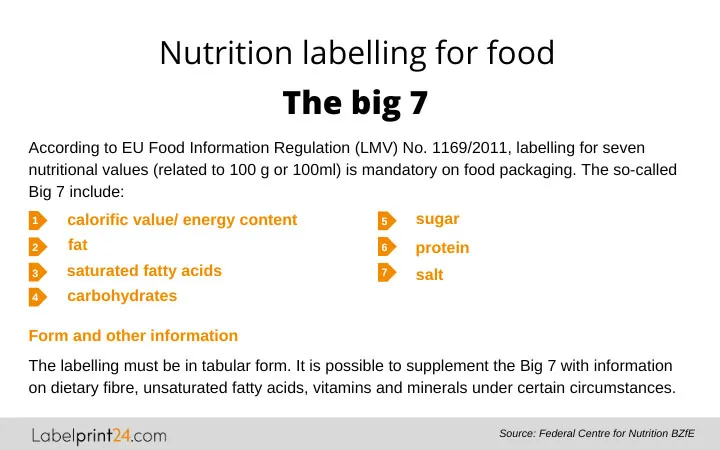
Legal requirements and consumer protection for labels
Labels play a crucial role in product labelling. They make important information visible directly on the product or on the packaging, such as information on ingredients, the best-before date, warnings, processing instructions and barcodes. To ensure consumer protection, there is a legally anchored product labelling obligation in Germany and Europe. It is legally stipulated which compulsory information the label must contain, what may not be written on it and which formal requirements must be met. You will find everything important about the labelling of food and medicines, advertising on labels, current developments and the possibilities for consumers to intervene in the case of incorrect and deceptive information in the following article.
.jpg)
Definition: Legal requirements for labels?
The purpose of product labelling is to provide consumers with information about certain product properties and characteristics. This is to enable customers to make an informed purchase decision while ensuring safe use of the product.
It can only fulfil these tasks if the information on the labels is honest and complete. If, for example, a product lacks information on allergens contained therein, this can be life-threatening for allergy sufferers in the worst case.

Likewise, manufacturers must provide information if a product is highly flammable or otherwise poses a risk to the end customer, e.g. through hazardous substance labelling.
The filling quantity, on the other hand, is not a safety requirement, but is absolutely necessary in order to compare the price-performance ratio of similar products from different suppliers.
Furthermore, the producer or distributor must be named so that the buyer can take action against the responsible party in case of defects.
The legal requirements for product labelling not only benefit consumers, but also manufacturers who value quality, honesty and transparency. Fair competition is only possible if misleading and false information on labels is prevented by comprehensive labelling regulations.
What are the basic requirements for food labelling?
Food labelling gives consumers a clear overview of which allergens, additives and genetically modified organisms a product contains. It also provides information on how much energy, fat, sugar or salt a food provides.
Based on this information, the potential buyer can get an idea of whether a food is more likely to be healthy or not. The most important information on food labelling labels includes:
- The designation: The designation specifies the exact nature of a product and its particular characteristics. There are legal requirements for some designations in special product regulations and in the German Food Code.
If the name is not defined by law, it must be formulated in such a way that it is clear and unambiguous what kind of food it is. - The list of ingredients: All ingredients must be listed on every packaged food. These must be listed in descending order of the percentage by weight at the time of production.
If an ingredient is mentioned in the food name or is highlighted by illustrations on the product packaging, the percentage by weight must also be listed.
The list of ingredients must also include all flavourings and food additives used. The additives must be named with the class name followed by the E-number or the chemical name.

- Nutrition labelling: Since December 2016, a nutrition declaration has been mandatory on food labels. This is usually presented in table form and always indicates the nutrient content in relation to 100 g or 100 ml for better comparability.
The nutritional value table must at least contain information on the so-called "Big 7". In addition to the calorific value, this includes the amounts of fat, saturated fatty acids, protein, carbohydrates, sugar and salt.
In addition, vitamins, dietary fibres and other nutritional values must be indicated if they are explicitly highlighted on the printed packaging.
- Allergen labelling: If included, the 14 most important substances or products that can lead to intolerances and allergic symptoms, such as wheat, mustard or nuts, must be listed in the list of ingredients. In addition, the allergens must be visually highlighted by the font, the font style (for example, boldface) or the background colour.
- The caffeine content: In the case of drinks with increased caffeine content (for example energy drinks), the label must indicate that they are not suitable for children, pregnant women and nursing mothers. The same applies to foods to which caffeine has been added for physiological reasons. In both cases, the exact caffeine content must be indicated.
- The alcohol content: On alcoholic beverages with an alcohol content of more than 1.2 percent by volume (for example beer, wine, sparkling wine, spirits), the actual alcohol content must be indicated in percent by volume.
- The net quantity: The net quantity informs about the contained quantity of the food by weight (g or kg), volume (ml or l) or number of pieces.
- The best-before or use-by date: The best-before date indicates how long a product will retain its specific properties if stored correctly. Perishable foods should be labelled with the use-by date instead. Products with a best-before date are also considered fit for consumption beyond this date. If a food product has exceeded its use-by date, it is no longer considered safe and must be disposed of.
- Origin labelling: The Food Information Regulation stipulates compulsory origin labeling where consumers need this information to make an informed purchasing decision. This is, for example, the situation when they could be deceived about the actual country of origin or place of provenance of a product without this information. Since April 2020, it is also necessary to indicate the origin of the primary ingredient if it does not match the country of origin or place of provenance of the product.
How must medicines be labelled?
The labelling obligation for medicinal products is regulated by the Medicinal Products Act (AMG). In principle, only persons who have a manufacturing authorisation according to § 13 AMG may carry out the labelling. The most important labelling of medicinal products include:
- The medicinal product designation: The name of a medication corresponds to the product name. It can be a common, a scientific, or even a brand name.
- The active substances contained: The type and quantities of active substances and other ingredients must always be stated if the competent authority or a legal regulation prescribes it. The regulations may vary depending on the medicinal product.
- The strength of the medication: Depending on the dosage form, this information corresponds to the active ingredient content per unit of dosage, weight, or volume. It must always consist of a number and its associated unit of measurement. If a medicinal product contains two or more active ingredients, each strength indication must be provided separately with its respective unit of measurement. Additionally, when providing strength indications, the current SmPC guidelines and the "QRD Recommendations on the expression of strength in the name of centrally authorized human medicinal products" should be taken into account.
- User information: If the target user group is not part of the medication designation, it must be mentioned on the label. This information indicates whether a product is intended for infants, children, or adults. Age specifications may be further specified if they correspond to the approved indication.
- Expiration date: The expiration date informs the consumer about the date until which they can safely and effectively use the medication.
Special labelling obligations exist for:
- Homeopathic Medicinal Products (References to the Homeopathic Nature, Registration Information, and a Note to Consult a Doctor if Symptoms Persist)
- Genetically Engineered Medicinal Products (Mandatory Mention of the Genetically Modified Organism or Cell Line)
- Samples (Medicinal samples may only be provided to doctors, dentists, and veterinarians, and, if not subject to prescription, to individuals practicing dental or medical professions).

What applies with regard to advertising on labels?
Product advertising is an indispensable element in competition. The aim of all advertising measures is to make a product or brand stand out from its competitors and to encourage customers to buy it.
Information on specific product characteristics must not be arbitrary. The so-called Health Claims Regulation governs which nutritional and health-related statements are allowed on food labels. Approved nutritional claims include, for example:

- Energy-reduced (reduced calorific value by at least 30 per cent).
- sugar-free (no more than 0.5 g sugar per 100 g or 100 ml), sodium-free (maximum 0.005 g sodium per 100 g),
- high in fibre (at least 6 g fibre per 100 g or at least 3 g fibre per 100 kcal).
There are now also limits to health-related advertising messages. Currently, about 250 claims are approved throughout Europe, which mainly refer to vitamins and minerals. A prerequisite for the approval of a health claim is that it is based on generally accepted scientific evidence.
What are the developments and how can consumers take action against incorrect labelling?
In order to meet changing requirements and ensure consumer protection in the long term, product labelling is constantly being developed and adapted to new circumstances.
For example, one such change came into force in May 2022 in connection with the repricing of foodstuffs that are about to expire on their best-before date.
Whereas traders were previously obliged to produce a new price label, a simple note such as "20 per cent cheaper" in conjunction with information that the reduction is due to the short shelf life is now sufficient. A new basic or final price no longer needs to be attached.
If product packaging misleads consumers into believing that it contains more than it actually does, if the origin information is incorrect or if information on allergens, alcohol or caffeine is missing, consumers can turn to various authorities. Depending on the reason for the complaint, the following contacts may be considered:
- Offices for Food Control
- Offices for consumer protection
- Public order offices
- Veterinary offices
- Weights and Measures Offices
Conclusion
False statements on product labelling labels are consumer deception. If a yoghurt pot says "strawberry yoghurt" and is emblazoned with a picture of crunchy strawberries, the consumer is entitled to expect that the yoghurt contains real strawberries or at least natural strawberry flavouring.
Legal requirements for labels help protect customers from misleading and false information and honest producers from unfair competitors.
FAQ
- How large must the font be on labels for product labelling?
The font size on food packaging is regulated in the EU Food Regulation. According to this, information on food labels must have a font height of at least 1.2 mm, related to the small "x". If the label is very small because no larger label fits on the packaging, a font size of only 0.9 mm is permitted.




